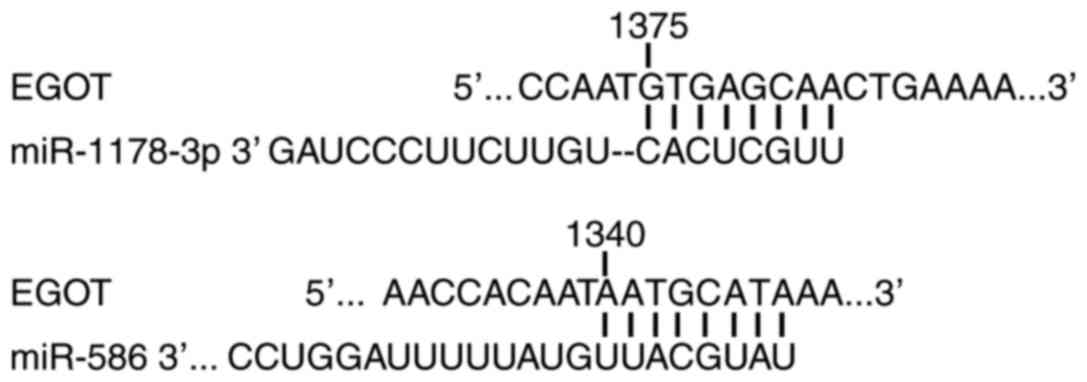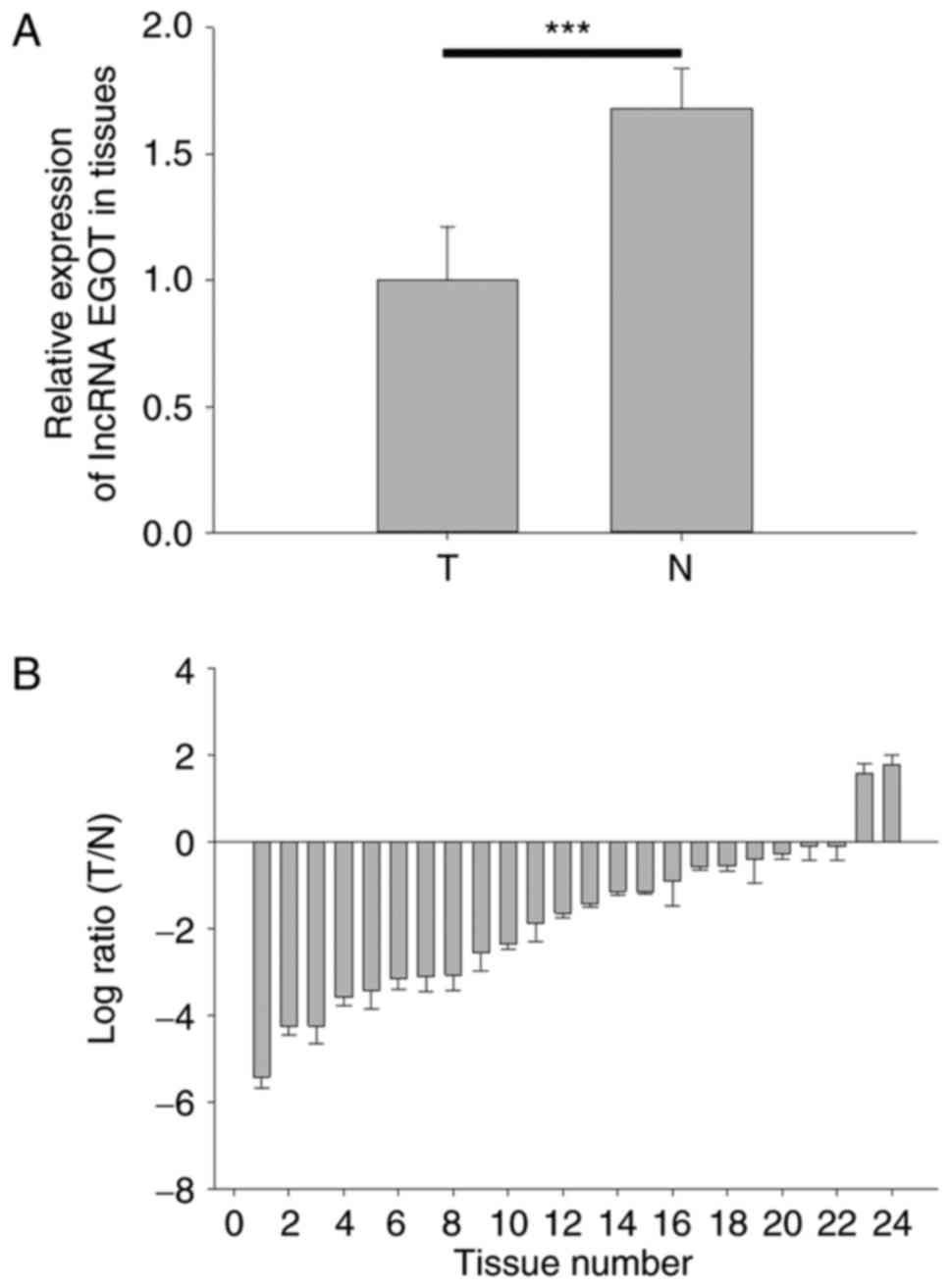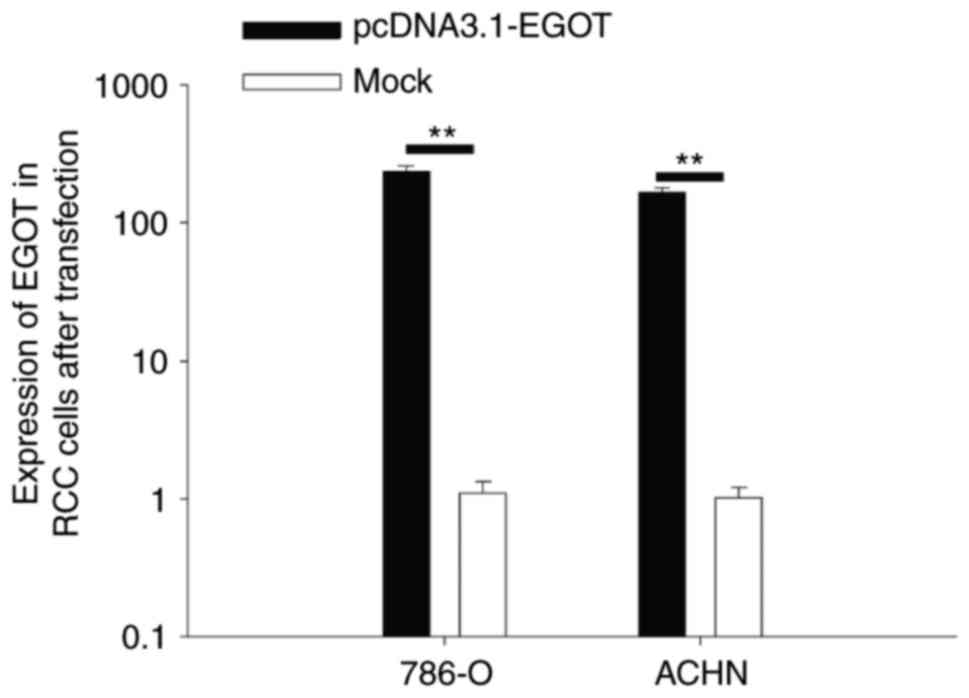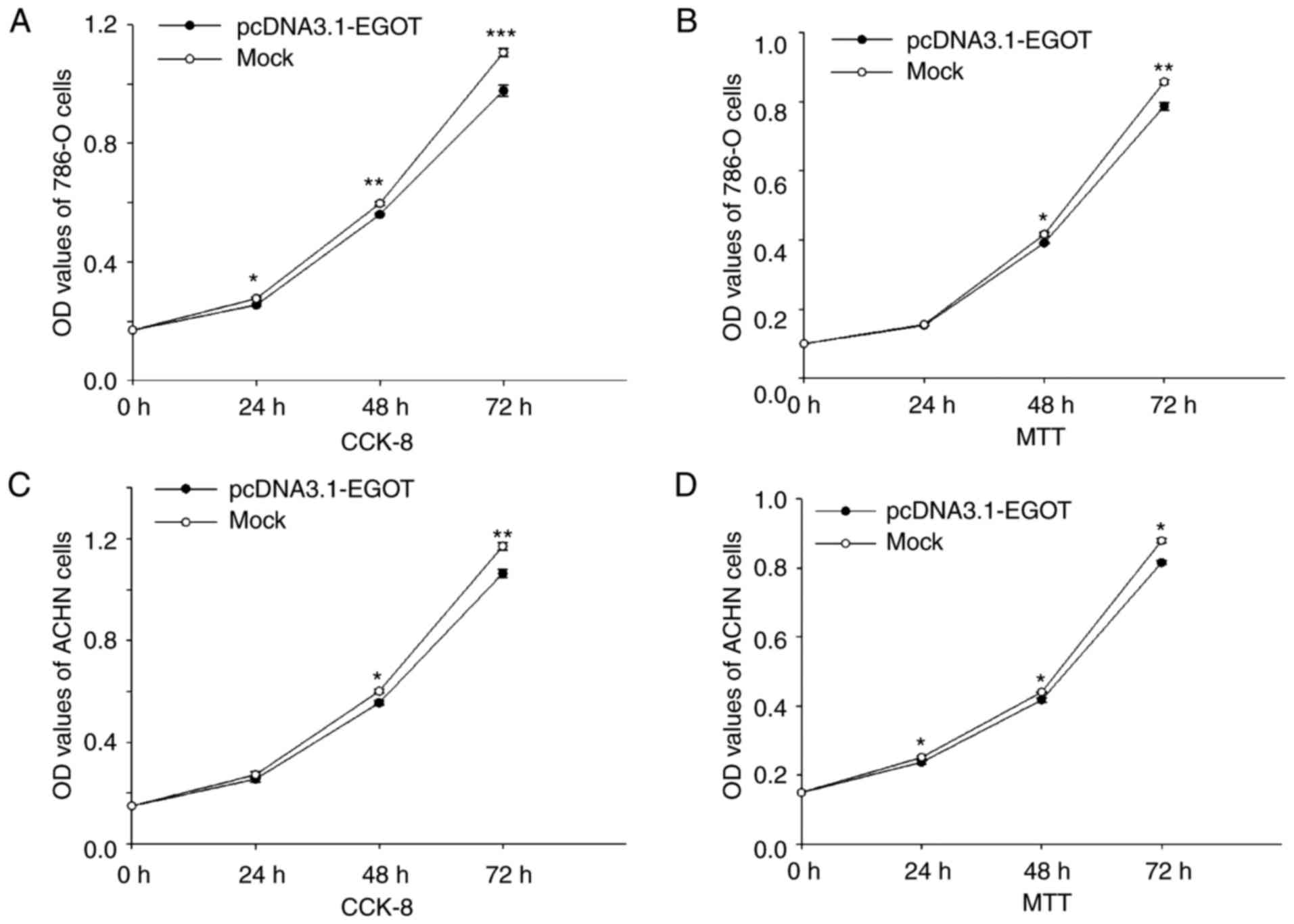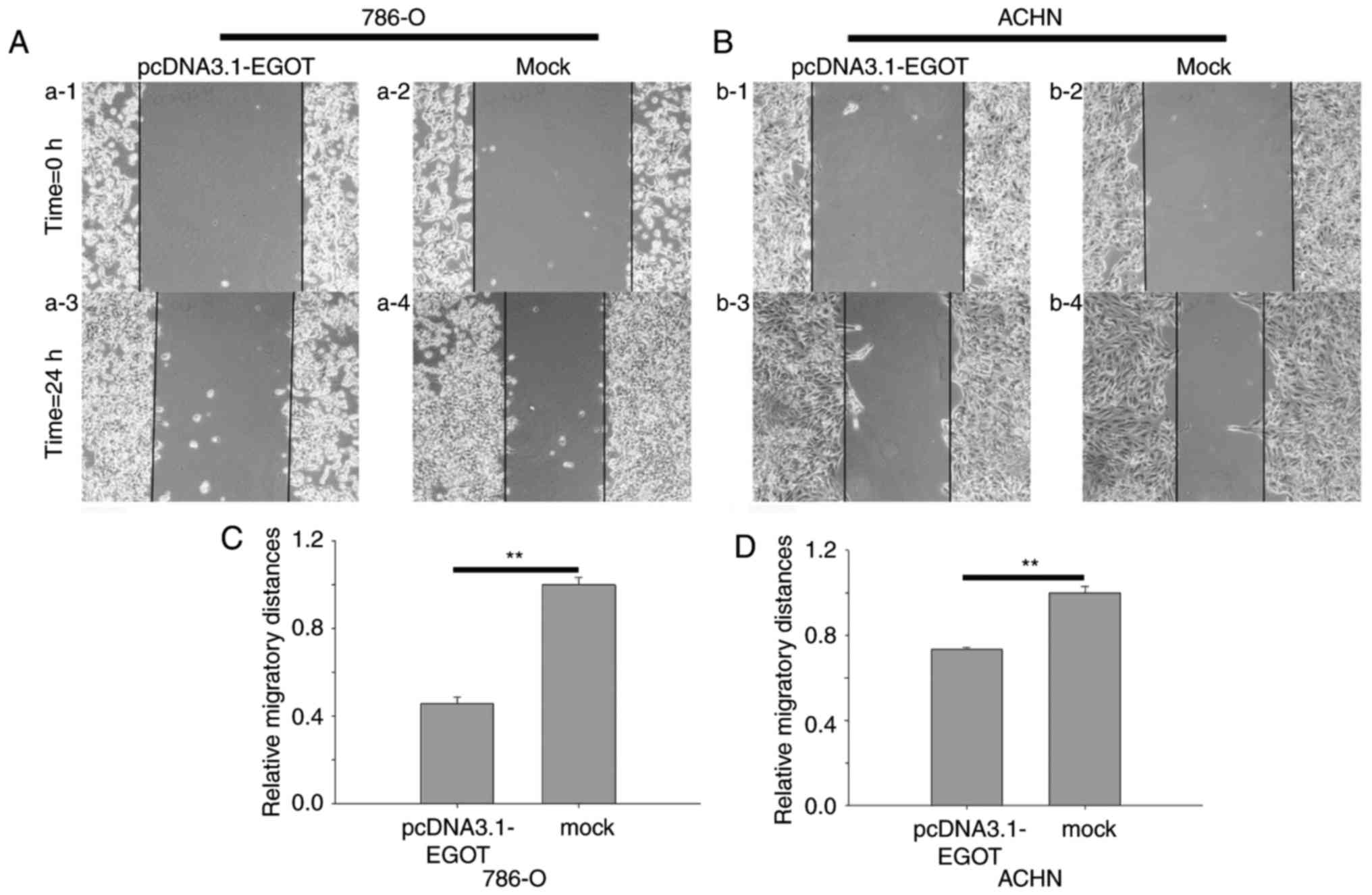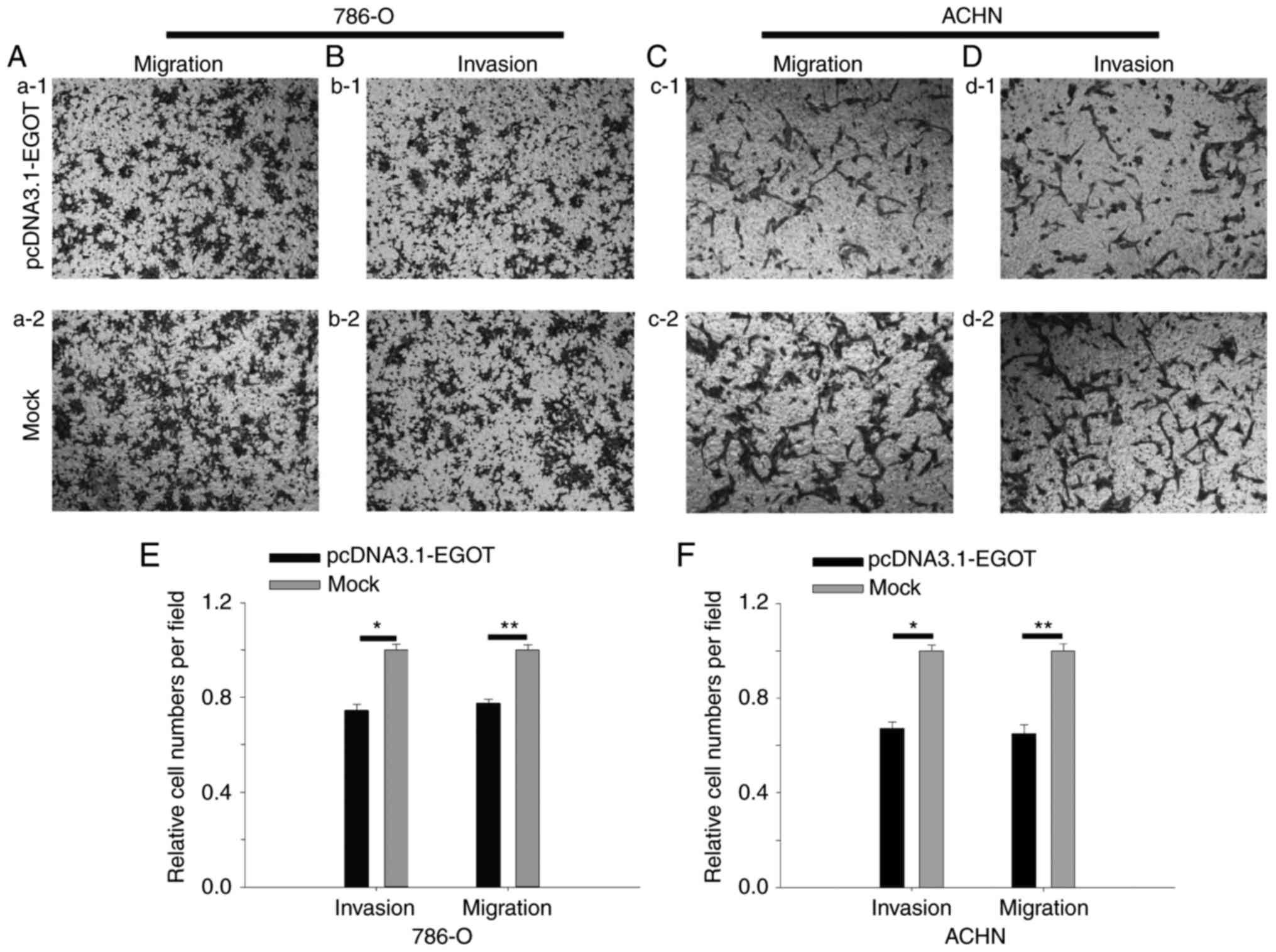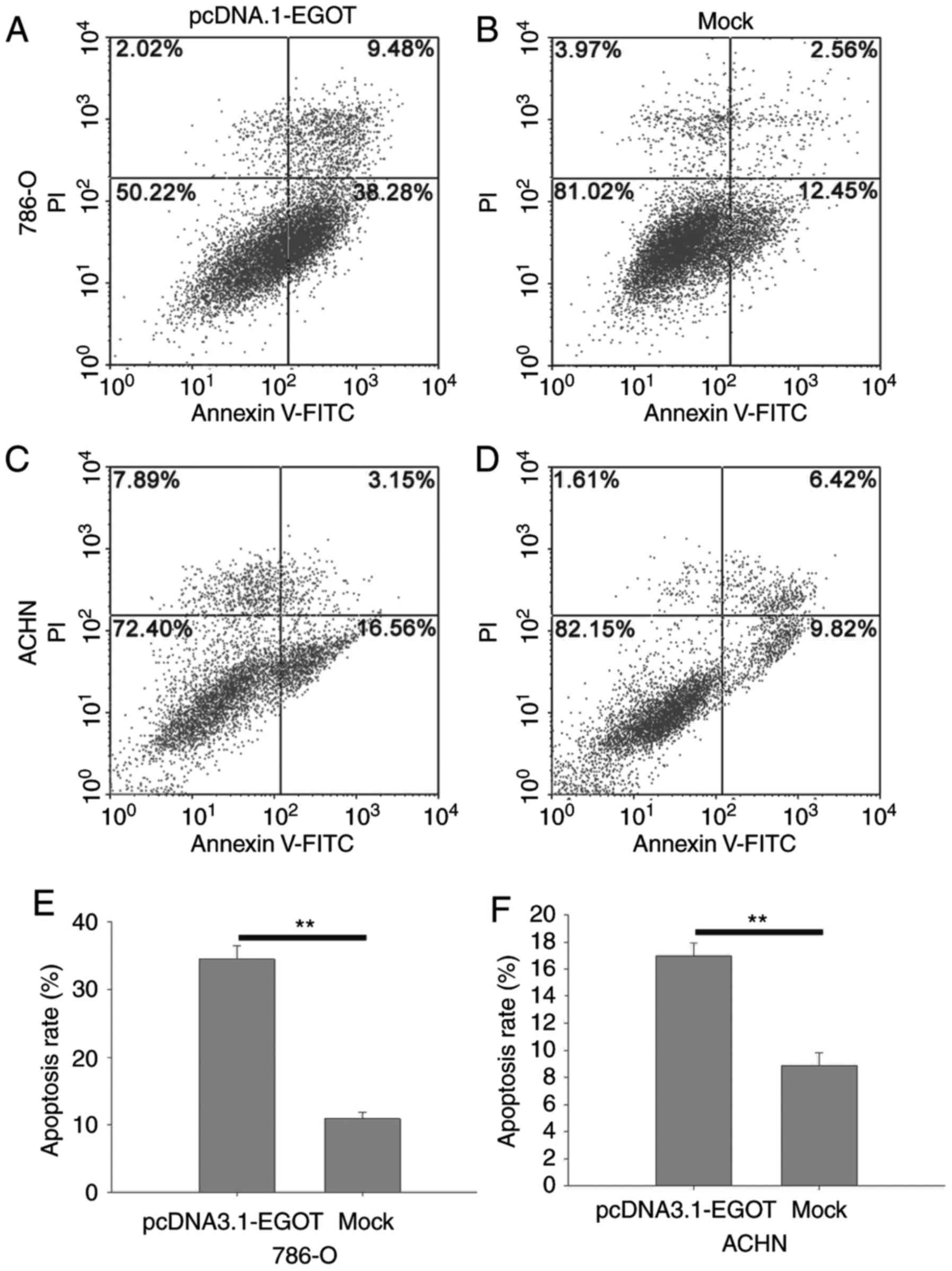Identification of lncRNA EGOT as a tumor suppressor in renal cell carcinoma
Corrigendum in: /10.3892/mmr.2024.13194
- Authors:
- Published online on: September 12, 2017 https://doi.org/10.3892/mmr.2017.7470
- Pages: 7072-7079
Abstract
Introduction
Renal cell carcinoma (RCC) is the most common type of kidney cancer and accounts for ~2–3% of all cases of cancer in adults (1). RCC may be resistant to chemotherapy and conventional radiation therapy, although surgical resection is an effective treatment (2–4). However, 30% of patients with RCC who undergo surgical resection suffer from recurrence (3,5). The prognosis of patients with RCC remains unfavorable, particularly for those with advanced tumors (6). It is essential to diagnose RCC as early as possible and to identify novel biomarkers for RCC.
Long non-coding RNAs (lncRNAs) are a group of non-protein coding transcripts that have a length of >200 nucleotides (7,8). lncRNAs were regarded as ‘transcriptional noise’ when identified initially. However, accumulating evidence has demonstrated that lncRNAs may influence gene expression via transcriptional, post-transcriptional or epigenetic regulation (9). With the development of whole-genome sequencing technologies, it is now clear that non-coding RNAs account for ≥90% of the human genome and serve important roles in different biological processes (10,11), including genome rearrangement (12), chromatin modifications (13), gene imprinting (14), cell cycle control (15) and X-chromosome inactivation (16). The lncRNA eosinophil granule ontogeny transcript (EGOT) is located at 3p26.1. A previous study revealed that lncRNA EGOT was downregulated in breast cancer, and its expression was associated with malignant status and poor prognosis (17). In addition, next-generation deep sequencing revealed that lncRNA EGOT may be functional in clear cell carcinoma (18); however, there appears to be no associated studies about lncRNA EGOT in RCC. In the present study, the expression and function of lncRNA EGOT in RCC was examined.
Materials and methods
Sample collection
A total of 24 paired RCC tissues (RCC and adjacent normal tissues) were collected from Peking University Shenzhen Hospital (Shenzhen, China) from December 2012 to December 2014. The adjacent normal tissues were 2 cm away from visible RCC lesions and negative for tumor tissues, as determined by microscopy. Tissues were immersed in RNAlater (Thermo Fisher Scientific, Inc., Waltham, MA, USA) for ≥30 min while being dissected, and subsequently stored at −80°C until further use. Written informed consent was obtained from all patients. Collection and usage of the samples were reviewed and approved by the Ethics Committees of Peking University Shenzhen Hospital (Shenzhen, China). The tissues collected were reviewed and classified by hematoxylin and eosin staining. The clinical and pathological characteristics of the patients are presented in Table I.
Cell culture
The 2 RCC cell lines, 786-O and ACHN, were purchased from the American Type Culture Collection (Manassas, VA, USA). Cells were cultured in a humidified incubator containing 5% CO2 at a temperature of 37°C in Dulbecco's modified Eagle's medium (Gibco; Thermo Fisher Scientific, Inc.) supplemented with 10% fetal bovine serum (Gibco; Thermo Fisher Scientific, Inc.), 1% glutamine (Gibco; Thermo Fisher Scientific, Inc.), 1 µl/ml penicillin and 1 µg/ml streptomycin sulfates.
Cell transfection
For overexpression of EGOT, the polymerase chain reaction (PCR)-amplified EGOT digested with BamHI and EcoRI restriction enzymes was subcloned into the pcDNA3.1 mammalian expression vector (Genepharm, Inc., Sunnyvale, CA, USA). The EGOT expression vector, pcDNA3.1-EGOT, was verified by sequencing. Synthesized pcDNA3.1-EGOT or mock (pcDNA3.1) was transfected (0.2 µg/well in 96-well plates; 4.0 µg/well in 6-well plates) into 80% confluent RCC cells using Lipofectamine 3000 (Invitrogen; Thermo Fisher Scientific, Inc.), which was mixed with Opti-MEM® I Reduced Serum medium (Gibco; Thermo Fisher Scientific, Inc.), according to the manufacturer's protocol. The transfection assay was performed at 37°C for 24 h. Reverse transcription-quantitative PCR (RT-qPCR) analysis was performed to detect the expression of EGOT in cells following transfection.
RNA extraction, cDNA synthesis and the RT-qPCR
RNAiso Plus reagent (Takara Bio, Inc., Otsu, Japan) was used to extract total RNA from tissues and cells, according to the manufacturer's protocol. The concentration of RNA was measured using a NanoDrop 2000/2000c spectrophotometer (Thermo Fisher Scientific, Inc.). Subsequently, 1 µg RNA was used to generate a cDNA library by performing RT with the PrimeScript™ RT reagent kit (Takara Bio, Inc.). The expression of EGOT was detected by qPCR with Premix Ex Taq™ II (Takara Bio, Inc.) on a Roche light cycler 480 Real-Time PCR system (Roche Applied Science, Penzberg, Germany). The qPCR thermocycling conditions were as follows: 95°C for 1 min, followed by 40 cycles of 95°C for 10 sec, 60°C for 30 sec, 70°C for 30 sec. GAPDH was used as an internal control and the sequences of the primers are listed in Table II. The expression level of EGOT in tissues and cells was analyzed via the 2−ΔΔCq method (19). RT-qPCR analysis was performed in triplicate.
Cell proliferation assay
The MTT and Cell Counting Kit-8 (CCK-8) assays were performed to assess the proliferative ability of the cells. After ~12 h seeding of ~3,000 cells/well in a 96-well plate, cells were transfected with pcDNA3.1-EGOT or mock. For the CCK-8 assay, following transfection, 10 µl CCK-8 (Beyotime Institute of Biotechnology, Haimen, China) was added into the wells for 1 h, prior to measuring the optical density (OD) value of each well using an ELISA microplate reader (Bio-Rad Laboratories, Inc., Hercules, CA, USA) at a wavelength of 490 nm. For the MTT assay, 20 µl MTT solution (5 mg/ml; Sigma-Aldrich, Merck KGaA, Darmstadt, Germany) was added to the wells for 4 h. The solution was subsequently replaced with 150 µl dimethyl sulfoxide (Sigma-Aldrich, Merck KGaA), and the OD value was measured at a wavelength of 490 nm following agitation of the wells for 15 min at room temperature. The experiments were performed in replicates of six and repeated ≥3 times.
Cell mobility assay
Cell scratch assay was performed to assess the cell mobility of 786-O and ACHN. Cells (~3×105 cells/well) were seeded into a 6-well plate and 24 h later were transfected with pcDNA3.1-EGOT or mock as aforementioned. The cell monolayer was scratched 24 h later with a sterile 200 µl pipette tip to generate a wound. Cells were then rinsed with phosphate-buffered saline to remove the floating cells, and then cells were cultured in DMEM supplemented with 5% FBS. Scratches were imaged at 0 h and after 24 h with a digital camera system. The experiments were performed in triplicate and repeated 3 times.
Transwell invasive and migratory assays were performed to assess the cell migratory and invasive ability. Transwell chamber inserts with (for migration) or without (for invasion) Matrigel (BD Biosciences, Franklin Lakes, NJ, USA) were used according to the manufacturer's protocol. Cells were transfected as aforementioned, resuspended in 200 µl DMEM without serum and seeded at a density of 1×104 cells/well into the upper channel of the inserts. The lower chamber contained DMEM supplemented with 10% serum. Cells were allowed to migrate for 36 h and invade for 48 h. The cells that had migrated or invaded to the bottom of the inserts were stained with crystal violet for 15 min at room temperature and counted using an inverted microscope. The experiments were performed in in triplicate and repeated at least 3 times.
Flow cytometric analysis
Flow cytometry was performed to detect the percentage of apoptotic cells following transfection with an Alexa Fluor® 488 Annexin V/Dead Cell Apoptosis kit (Invitrogen; Thermo Fisher Scientific, Inc.). Following seeding of ~3×105 cells/well in a six-well plate and incubation for 12 h, the cells were transfected with pcDNA3.1-EGOT or mock. Following 48 h of transfection, all the cells were harvested and stained according to the manufacturer's protocol, and the percentage of apoptotic cells was determined by flow cytometry and analyzed using FlowJo version X (FlowJo LLC, Ashland, OR, USA). The experiments were performed in triplicate and repeated ≥3 times.
Prediction of EGOT-associated microRNA (miRNA/miR)
Prediction of associated miRNAs was determined by computational algorithms according to base-pairing rules between miRNA and mRNA target sites, location of binding sequences within the 3′-untranslated region of the target and conservation of target binding sequences. In the present study, miRDB (mirdb.org/miRDB/index.html) and miRWalk (http://www.umm.uni-heidelberg.de/apps/zmf/mirwalk) were used. Putative miRNAs were miR-1178-3p (previous name miR-1178) and miR-586, and the binding site is displayed in Fig. 1.
Statistical analysis
A paired t-test was used to compare the expression levels of EGOT in matched tumor/normal tissues, and in cells following transfection. A Student's t-test was used to characterize the phenotypes of cells. All statistical analyses were performed using the SPSS version 19.0 statistical software package (IBM Corp., Armonk, NY, USA). Data are presented as the mean ± standard error. P<0.05 was considered to indicate a statistically significant difference.
Results
lncRNA EGOT is downregulated in RCC tissues
To detect the expression level of lncRNA EGOT in RCC tissues and paired normal tissues, RT-qPCR analysis was performed. The expression levels of lncRNA EGOT in RCC tissues (1±0.213) was significantly decreased compared with adjacent normal tissues (1.68±0.16) (Fig. 2A; P<0.001). The relative expression levels of lncRNA EGOT in the 24 tissues demonstrated that lncRNA EGOT was downregulated in 22 RCC tissues compared with normal adjacent tissues (Fig. 2B).
Validation of the expression of lncRNA EGOT following transfection
RT-qPCR analysis was performed to detect the expression of lncRNA EGOT in RCC cells following transfection. The results demonstrated that the expression of lncRNA EGOT was increased 236.39-fold (786-O cells) and 167.15-fold (ACHN cells) in cells transfected with pcDNA3.1-EGOT compared with cells transfected with mock (empty pcDNA3.1) (P<0.01; Fig. 3).
lncRNA EGOT suppresses cell proliferation
MTT and CCK-8 assays were performed to assess cell proliferation. In 786-O cells, compared with the mock group, proliferation was reduced by 7.75% (24 h; P<0.05), 6.27% (48 h; P<0.01) and 11.67% (72 h; P<0.001) when measured by the CCK-8 assay (Fig. 4A), and by 1.43% (24 h), 5.98% (48 h; P<0.05) and 8.24% (72 h; P<0.01) when measured by the MTT assay (Fig. 4B), following upregulation of lncRNA EGOT using the pcDNA3.1-EGOT plasmid. In addition, upregulation of lncRNA EGOT using the pcDNA3.1-EGOT plasmid suppressed ACHN cell proliferation by 6.26% (24 h), 7.60% (48 h; P<0.05) and 9.11% (72 h; P<0.01) when measured by the CCK-8 assay (Fig. 4C), and by 5.58% (24 h; P<0.05), 5.14% (48 h; P<0.05) and 7.21% (72 h; P<0.05) when measured by the MTT assay (Fig. 4D). These results suggested that lncRNA EGOT may suppress RCC cell proliferation.
lncRNA EGOT suppresses RCC cell mobility
Wound-healing, Transwell migratory and Transwell invasive assays were performed in the present study. The results of the wound-healing assay demonstrated that at 24 h, the migratory distance of cells transfected with pcDNA3.1-EGOT was reduced by 54.23% compared with the mock group in 786-O cells (P<0.01), and by 26.60% in ACHN cells (P<0.01) (Fig. 5).
The results of the Transwell assay revealed that in 786-O cells, upregulation of lncRNA EGOT reduced invasive ability by 25.45% (P<0.05) and migratory ability by 22.42% (P<0.01). For ACHN cells, upregulation of lncRNA EGOT reduced invasive the number of cells by 32.80% (P<0.05) and migratory ability by 34.84% (P<0.05) (Fig. 6). The results suggested that lncRNA EGOT suppressed RCC cell mobility.
lncRNA EGOT induces cell apoptosis
The percentage of apoptotic cells was quantified by flow cytometry (Fig. 7). The results demonstrated that the apoptotic rate in 786-O cells transfected with pcDNA3.1-EGOT was 34.50%, compared with an apoptotic rate of 10.93% in mock cells (P<0.01). In ACHN cells, the apoptosis rate of cells transfected with pcDNA3.1-EGOT was 16.96% compared with an apoptotic rate of 8.89% in mock cells (P<0.01). These results suggested that EGOT may induce cellular apoptosis in RCC cell lines.
Discussion
lncRNAs have been implicated in multiple molecular mechanisms, including transcriptional regulation, post-transcriptional regulation and processing of other short lncRNAs (20). Accumulating evidence has demonstrated that lncRNA serves an important role in tumorigenesis and the development of RCC. Malouf et al (18) identified 1,934 expressed lncRNAs by next-generation deep sequencing in 475 cases of primary clear cell (cc)RCC, and the expression of 1,070 lncRNAs demonstrated a strong association with the mRNA expression of their neighboring genes. In another study, Blondeau et al (21) reported 1,308 dysregulated lncRNAs in ccRCC. Another microarray assay revealed 27,279 lncRNAs in RCC samples, of which 897 were markedly dysregulated (22). To date, it appears that only a small number of studies have investigated the function or underlying mechanism of lncRNAs in RCC (23–25), and the way in which lncRNAs regulate RCC cell behavior remains to be identified.
lncRNA EGOT, located at 3p26.1, is nested within an intron of the gene encoding inositol triphosphate receptor type 1, and may be involved in eosinophil development and in the maturation of eosinophils, in addition to regulating protein and eosinophil-derived neurotoxin expression (26). A subsequent study (17) revealed that lncRNA EGOT was downregulated in breast cancer, and that decreased expression levels of EGOT were significantly associated with larger tumor size, lymph node metastasis and poor prognosis. However, it appears that no studies have investigated the role of EGOT in RCC. Based on previously published studies (17,18,26), the expression and function of EGOT was examined in RCC in the present study.
In the present study, the expression levels of EGOT in RCC and adjacent normal tissues was detected by RT-qPCR analysis, and the results revealed that EGOT was downregulated in RCC tissues compared with adjacent normal tissues. The function of EGOT in RCC cells (786-O and ACHN) was additionally examined. The results revealed that EGOT upregulation partially suppressed RCC cell proliferation, migration and invasion, and induced RCC cell apoptosis. EGOT upregulation resulted in slight alterations in cell proliferation, although this was not statistically significant, which suggested that EGOT primarily affects RCC cell migration, invasion and apoptosis. Therefore, EGOT may serve as a tumor suppressor in RCC.
There is only a small number of studies that have investigated the expression or function of lncRNAs in RCC. lncRNA urothelial carcinoma-associated 1 (UCA1), metastasis-associated lung adenocarcinoma transcript-1 (MALAT1), homeobox transcript antisense RNA (HOTAIR) and renal cell carcinoma related transcript-1 (RCCRT1) have been demonstrated to be upregulated in RCC (27–31). In particular, the expression levels of RCCRT1 and MALAT1 were associated with poor prognosis, and UCA1, HOTAIR and RCCRT1 were associated with RCC cell migration, invasion or proliferation (27–31). lncRNA growth arrest-specific transcript 5, maternally expressed 3, cancer susceptibility candidate 2 and TRIM52 antisense RNA 1 were downregulated in RCC, affecting cell function (23,25,32,33). Another study revealed that lncRNA-suppressing androgen receptor in renal cell carcinoma may suppress hypoxic cell cycle progression in von Hippel-Lindau (VHL)-mutant RCC cells; however, SARCC may induce hypoxic cell cycle progression in VHL-restored RCC cells (34), which suggested that lncRNA SARCC may be a potential novel therapeutic biomarker. Therefore, the roles of lncRNAs in RCC remain to be identified and a greater number of studies that focus on this are required.
In conclusion, lncRNA EGOT was downregulated in RCC tissues compared with normal tissues. EGOT may affect RCC cell proliferation, migration, invasion and apoptosis, which indicated that EGOT may serve an important role in the tumorigenesis of RCC. In a future study, a dual-luciferase assay will be performed to explore the association between EGOT and miR-1178-3p or miR-586, which were identified in the present study to be putative regulators of EGOT. The possible downstream effector would be screened by microarray analysis and western blotting.
Acknowledgements
The present study was supported by the Guangdong Natural Science Foundation (grant nos. 2014A030313709 and 2015A030313889), the Fund of Shenzhen Key Laboratory (grant no. ZDSYS201504301045406) and the ‘San-ming’ Project of Medicine in Shenzhen.
References
|
Chow WH and Devesa SS: Contemporary epidemiology of renal cell cancer. Cancer J. 14:288–301. 2008. View Article : Google Scholar : PubMed/NCBI | |
|
Iliopoulos O: Molecular biology of renal cell cancer and the identification of therapeutic targets. J Clin Oncol. 24:5593–5600. 2006. View Article : Google Scholar : PubMed/NCBI | |
|
Liu WS, Liu YD, Fu Q, Zhang WJ, Xu L, Chang Y and Xu JJ: Prognostic significance of ubiquinol-cytochrome c reductase hinge protein expression in patients with clear cell renal cell carcinoma. Am J Cancer Res. 6:797–805. 2016.PubMed/NCBI | |
|
Xiang C, Cui SP and Ke Y: MiR-144 inhibits cell proliferation of renal cell carcinoma by targeting MTOR. J Huazhong Univ Sci Technolog Med Sci. 36:186–192. 2016. View Article : Google Scholar : PubMed/NCBI | |
|
Yu Z, Ni L, Chen D, Su Z, Yu W, Zhang Q, Wang Y, Li C, Gui Y and Lai Y: Expression and clinical significance of RCDG1 in renal cell carcinoma: A novel renal cancer-associated gene. Mol Med Rep. 10:1583–1589. 2014. View Article : Google Scholar : PubMed/NCBI | |
|
Jiang Z, Chu PG, Woda BA, Rock KL, Liu Q, Hsieh CC, Li C, Chen W, Duan HO, McDougal S and Wu CL: Analysis of RNA-binding protein IMP3 to predict metastasis and prognosis of renal-cell carcinoma: A retrospective study. Lancet Oncol. 7:556–564. 2006. View Article : Google Scholar : PubMed/NCBI | |
|
Zhou X, Chen J and Tang W: The molecular mechanism of HOTAIR in tumorigenesis, metastasis, and drug resistance. Acta Biochim Biophys Sin (Shanghai). 46:1011–1015. 2014. View Article : Google Scholar : PubMed/NCBI | |
|
Iranpour M, Soudyab M, Geranpayeh L, Mirfakhraie R, Azargashb E, Movafagh A and Ghafouri-Fard S: Expression analysis of four long noncoding RNAs in breast cancer. Tumour Biol. 37:2933–2940. 2016. View Article : Google Scholar : PubMed/NCBI | |
|
Lan WG, Xu DH, Xu C, Ding CL, Ning FL, Zhou YL, Ma LB, Liu CM and Han X: Silencing of long non-coding RNA ANRIL inhibits the development of multidrug resistance in gastric cancer cells. Oncol Rep. 36:263–270. 2016. View Article : Google Scholar : PubMed/NCBI | |
|
Melissari MT and Grote P: Roles for long non-coding RNAs in physiology and disease. Pflugers Arch. 468:945–958. 2016. View Article : Google Scholar : PubMed/NCBI | |
|
Cui M, You L, Ren X, Zhao W, Liao Q and Zhao Y: Long non-coding RNA PVT1 and cancer. Biochem Biophys Res Commun. 471:10–14. 2016. View Article : Google Scholar : PubMed/NCBI | |
|
Nowacki M, Vijayan V, Zhou Y, Schotanus K, Doak TG and Landweber LF: RNA-mediated epigenetic programming of a genome-rearrangement pathway. Nature. 451:153–158. 2008. View Article : Google Scholar : PubMed/NCBI | |
|
Guttman M, Amit I, Garber M, French C, Lin MF, Feldser D, Huarte M, Zuk O, Carey BW, Cassady JP, et al: Chromatin signature reveals over a thousand highly conserved large non-coding RNAs in mammals. Nature. 458:223–227. 2009. View Article : Google Scholar : PubMed/NCBI | |
|
Pandey RR, Mondal T, Mohammad F, Enroth S, Redrup L, Komorowski J, Nagano T, Mancini-Dinardo D and Kanduri C: Kcnq1ot1 antisense noncoding RNA mediates lineage-specific transcriptional silencing through chromatin-level regulation. Mol Cell. 32:232–246. 2008. View Article : Google Scholar : PubMed/NCBI | |
|
Mourtada-Maarabouni M, Pickard MR, Hedge VL, Farzaneh F and Williams GT: GAS5, a non-protein-coding RNA, controls apoptosis and is downregulated in breast cancer. Oncogene. 28:195–208. 2009. View Article : Google Scholar : PubMed/NCBI | |
|
Autuoro JM, Pirnie SP and Carmichael GG: Long noncoding RNAs in imprinting and X chromosome inactivation. Biomolecules. 4:76–100. 2014. View Article : Google Scholar : PubMed/NCBI | |
|
Xu SP, Zhang JF, Sui SY, Bai NX, Gao S, Zhang GW, Shi QY, You ZL, Zhan C and Pang D: Downregulation of the long noncoding RNA EGOT correlates with malignant status and poor prognosis in breast cancer. Tumour Biol. 36:9807–9812. 2015. View Article : Google Scholar : PubMed/NCBI | |
|
Malouf GG, Zhang J, Yuan Y, Compérat E, Rouprêt M, Cussenot O, Chen Y, Thompson EJ, Tannir NM, Weinstein JN, et al: Characterization of long non-coding RNA transcriptome in clear-cell renal cell carcinoma by next-generation deep sequencing. Mol Oncol. 9:32–43. 2015. View Article : Google Scholar : PubMed/NCBI | |
|
Schmittgen TD and Livak KJ: Analyzing real-time PCR data by the comparative C(T) method. Nat Protoc. 3:1101–1108. 2008. View Article : Google Scholar : PubMed/NCBI | |
|
Kunej T, Obsteter J, Pogacar Z, Horvat S and Calin GA: The decalog of long non-coding RNA involvement in cancer diagnosis and monitoring. Crit Rev Clin Lab Sci. 51:344–357. 2014. View Article : Google Scholar : PubMed/NCBI | |
|
Blondeau JJ, Deng M, Syring I, Schrödter S, Schmidt D, Perner S, Müller SC and Ellinger J: Identification of novel long non-coding RNAs in clear cell renal cell carcinoma. Clin Epigenetics. 7:102015. View Article : Google Scholar : PubMed/NCBI | |
|
Qin C, Han Z, Qian J, Bao M, Li P, Ju X, Zhang S, Zhang L, Li S, Cao Q, et al: Expression pattern of long non-coding RNAs in renal cell carcinoma revealed by microarray. PLoS One. 9:e993722014. View Article : Google Scholar : PubMed/NCBI | |
|
Liu Z, Yan HY, Xia SY, Zhang C and Xiu YC: Downregulation of long non-coding RNA TRIM52-AS1 functions as a tumor suppressor in renal cell carcinoma. Mol Med Rep. 13:3206–3212. 2016. View Article : Google Scholar : PubMed/NCBI | |
|
Hirata H, Hinoda Y, Shahryari V, Deng G, Nakajima K, Tabatabai ZL, Ishii N and Dahiya R: Long noncoding RNA MALAT1 promotes aggressive renal cell carcinoma through Ezh2 and interacts with miR-205. Cancer Res. 75:1322–1331. 2015. View Article : Google Scholar : PubMed/NCBI | |
|
Wang M, Huang T, Luo G, Huang C, Xiao XY, Wang L, Jiang GS and Zeng FQ: Long non-coding RNA MEG3 induces renal cell carcinoma cells apoptosis by activating the mitochondrial pathway. J Huazhong Univ Sci Technolog Med Sci. 35:541–545. 2015. View Article : Google Scholar : PubMed/NCBI | |
|
Wagner LA, Christensen CJ, Dunn DM, Spangrude GJ, Georgelas A, Kelley L, Esplin MS, Weiss RB and Gleich GJ: EGO, a novel, noncoding RNA gene, regulates eosinophil granule protein transcript expression. Blood. 109:5191–5198. 2007. View Article : Google Scholar : PubMed/NCBI | |
|
Zhang HM, Yang FQ, Chen SJ, Che J and Zheng JH: Upregulation of long non-coding RNA MALAT1 correlates with tumor progression and poor prognosis in clear cell renal cell carcinoma. Tumour Biol. 36:2947–2955. 2015. View Article : Google Scholar : PubMed/NCBI | |
|
Li Y, Wang T, Li Y, Chen D, Yu Z, Jin L, Ni L, Yang S, Mao X, Gui Y and Lai Y: Identification of long-non coding RNA UCA1 as an oncogene in renal cell carcinoma. Mol Med Rep. 13:3326–3334. 2016. View Article : Google Scholar : PubMed/NCBI | |
|
Pei CS, Wu HY, Fan FT, Wu Y, Shen CS and Pan LQ: Influence of curcumin on HOTAIR-mediated migration of human renal cell carcinoma cells. Asian Pac J Cancer Prev. 15:4239–4243. 2014. View Article : Google Scholar : PubMed/NCBI | |
|
Wu Y, Liu J, Zheng Y, You L, Kuang D and Liu T: Suppressed expression of long non-coding RNA HOTAIR inhibits proliferation and tumourigenicity of renal carcinoma cells. Tumour Biol. 35:11887–11894. 2014. View Article : Google Scholar : PubMed/NCBI | |
|
Song S, Wu Z, Wang C, Liu B, Ye X, Chen J, Yang Q, Ye H, Xu B and Wang L: RCCRT1 is correlated with prognosis and promotes cell migration and invasion in renal cell carcinoma. Urology. 84:730.e1–e7. 2014. View Article : Google Scholar | |
|
Qiao HP, Gao WS, Huo JX and Yang ZS: Long non-coding RNA GAS5 functions as a tumor suppressor in renal cell carcinoma. Asian Pac J Cancer Prev. 14:1077–1082. 2013. View Article : Google Scholar : PubMed/NCBI | |
|
Cao Y, Xu R, Xu X, Zhou Y, Cui L and He X: Downregulation of lncRNA CASC2 by microRNA-21 increases the proliferation and migration of renal cell carcinoma cells. Mol Med Rep. 14:1019–1025. 2016. View Article : Google Scholar : PubMed/NCBI | |
|
Zhai W, Sun Y, Jiang M, Wang M, Gasiewicz TA, Zheng J and Chang C: Differential regulation of lncRNA-SARCC suppresses VHL-mutant RCC cell proliferation yet promotes VHL-normal RCC cell proliferation via modulating androgen receptor/HIF-2α/C-MYC axis under hypoxia. Oncogene. 35:4866–4880. 2016. View Article : Google Scholar : PubMed/NCBI |



